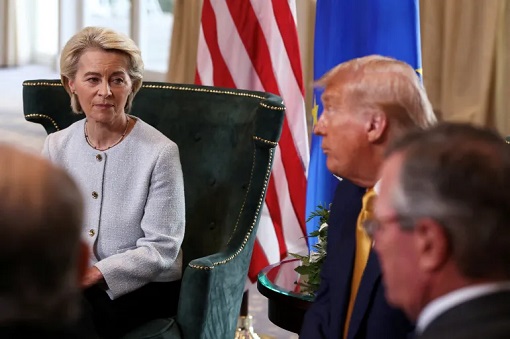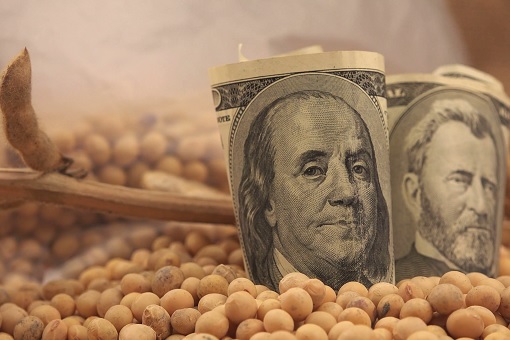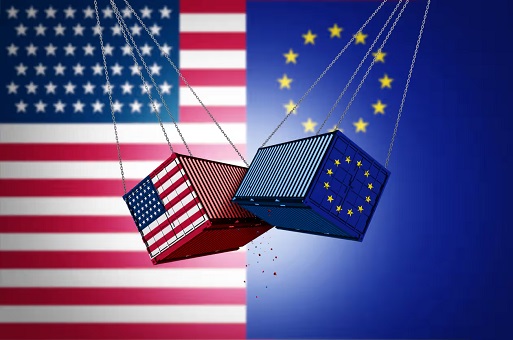
US-EU Giant Trade Deal – Why Europe Pretends 15% Tariff “Bad Deal” Is A Good Deal
July 29th, 2025 by financetwitter

President Donald Trump and European Commission President Ursula von der Leyen, who leads the EU’s executive body, announced a preliminary deal on Sunday (July 27) that saw the U.S. imposed tariffs of 15% on most goods entering the U.S. from Europe. In addition, European companies would buy US$750 billion worth of American energy products over three years and invest an additional US$600 billion in the U.S.
Aircraft and their components, certain chemicals, semiconductor equipment and some agricultural products looked set to be exempted from the new tariffs. In general, about 70% of European products will be affected by the 15% levy. One sector that celebrates the deal is the car industry. The 15% rate is higher than the 27.5% that was in place before 2025.
While it is indeed “the biggest trade deal ever”, as trumpeted by both Ursula and Trump for political reasons, the giant deal involving trades value of nearly US$2 trillion in goods and services per year between the U.S. and E.U. is actually a bad deal for Europe. Clearly, Trump is the biggest winner in this deal, pressuring the weak negotiator Ms. von der Leyen all the way to the finish line.

Sure, the 15% rate is half of what Trump had threatened. But when the UK was slapped with a 10% tariff in its trade deal with the U.S. in May, most of the European leaders mocked and ridiculed it as a bad deal. If Britain’s 10% tariff was bad, a 15% tariff on European goods, forced purchases of U.S. energy and military equipment and zero tariff retaliation by Europe is definitely worse.
To make matters worse, Trump said the U.S. will keep in place a 50% tariff on steel and aluminium, although the European Commission president said the tariffs on steel could be replaced with a quota system with further negotiation. There was also confusion over pharmaceuticals – Trump said the sector would be excluded, but a senior US official later said they will be subject to 15% tariff.
A zero tariff regime for wine and spirits – a point of friction on both sides of the Atlantic – is still under discussion. The EU will open new market access for U.S. Alaska pollock, Pacific salmon and shrimp, subject to quotas. It will also offer improved access for U.S. soya bean oil, planting seeds, grains and nuts as well as processed food such as tomato ketchup, cocoa and biscuits, again subject to quotas.

Of course, Ursula von der Leyen wanted to save face and was desperate to strike a deal, therefore, she had no choice but to praise the deal. However, French Prime Minister Francois Bayrou has criticised the deal – “It is a dark day when an alliance of free peoples, brought together to affirm their common values and to defend their common interests, resigns itself to submission.”
Francois Bayrou was joined by at least two other French government ministers as well as Viktor Orban, the Hungarian leader, who said that Trump “ate von der Leyen for breakfast”. German Chancellor Friedrich Merz, who initially welcomed the trade deal, later made a U-turn and said the automotive sector could experience “substantial damage” from Trump’s tariffs on cars.
This comes after powerful BDI federation of industrial groups expressed its disappointment. “Even a 15% tariff rate will have immense negative effects on export-oriented German industry,” – said Wolfgang Niedermark, a member of the federation’s leadership. Obviously, automaker Volkswagen, which suffered a 1.3 billion Euro (US$1.5 billion) hit on its profit in the first half of the year, will be hit substantially thanks to the tariffs.

Many European leaders were voicing frustration because the deal leaves the EU “worse off” than before Mr Trump’s “liberation day” tariffs were imposed earlier this year, and were happy to pass blame to the EU’s leadership for the deal. Ireland, which has become a base for huge American pharmaceutical firms due to its low corporate taxes, is also economically exposed.
At the same time, the U.S.-E.U. trade deal also creates a division on the island of Ireland, as traders in Northern Ireland can sell into America on a 10% tariff rate, courtesy of the UK deal, while their neighbours in Ireland will be hit with the 15% rate. Though von der Leyen framed the agreement as a “good deal” that would bring “stability” and “predictability”, Brussels’ original aim in the talks was for a “zero-for-zero” tariff deal.
Even if the European Union could not get zero tariff, the bloc had hoped to negotiate a 10% across-the-board rate. Still, the 15% rate on EU would be in line with what other American trading partners, including Japan. And just like the EU, Tokyo has also agreed to invest US$550 billion in key American sectors, never mind Wall Street has serious doubts that the Japanese huge investment will actually materialize.

Still, it’s not a done deal after Washington said that Trump retained the ability to increase the tariffs in the future if European countries do not live up to the investment commitments contained in the deal. Essentially, the U.S. president could change the terms of the deal whenever he likes or whenever the EU leaders offend Donald Trump for whatever reason.
The European Union imported 375.9 billion Euros (US$442 billion) worth of liquefied natural gas (LNG), petroleum, and natural gas products in 2024. But the problem is such purchases are not something that the European Union as a bloc has power over. The spending on energy purchases, let alone investment promises, comes from each of the 27 European member states.
A recent analysis by Capital Economics said a 15% baseline tariff would lower the EU’s gross domestic product (GDP) by about 0.5%. The deal will need to be signed off by all 27 members of the EU, with each of them having different interests and levels of reliance on the export of goods to the United States. So, not everyone agrees with the new tariff rate, and not everyone will blindly sign the deal.

So far, it appears that President Trump has achieved a remarkable success, as far as raising tariffs to a very high level, before slashing it to the relief of trading partners. Japan and the EU have together committed to investing US$1.15 trillion in the U.S. And what did the U.S. give up in return? Nothing.Both allies had threatened to retaliate, but never pulled the trigger, allowing Trump to call their bluff.
Along with the economic pain of a trade war, Europe feared Trump would abandon Ukraine and perhaps NATO altogether. The EU has to pay the price in order for Trump to commit to the trans-Atlantic security alliance. With the exception of China, it certainly looks like Donald Trump has achieved success in rebalancing the trade relationship between the U.S. and its allies.
The alternative to the EU deal with the US would be a submissive deal with CCP.
ReplyDeleteIn the end it was about calculations on which toxin is more dangerous .
Chinese alternative deal?
ReplyDeleteWhat kind of foul gaseous r u inhaling?
Ooop… too much zionist farts, perhaps!